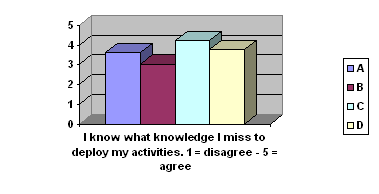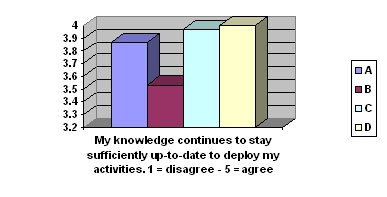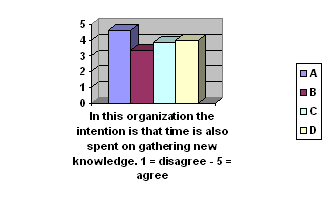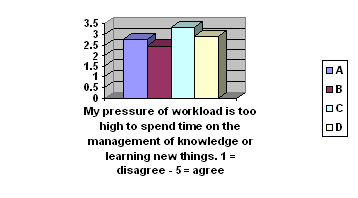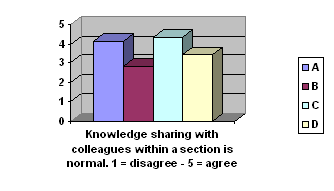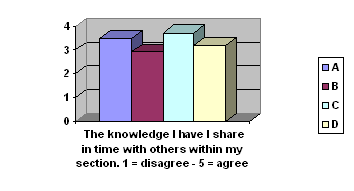JILT 2005 Issue 2 & 3 - Law Firms and IT: Towards Optimal Knowledge Management
|
Contents 2.2 A Taxonomy of Knowledge of Lawyers 3. Knowledge Processes in Law Firms 3.2 A Taxonomy of Knowledge Processes 3.3 Outcome of the Questionnaire 4. Information Technology in Law Firms 4.2 A Taxonomy of IT Support for Lawyers 4.3 Use of IT for Knowledge Management in Law Firms Law Firms and IT: Towards Optimal Knowledge Management
Martin Apistola
|
||||||||||||||||||||||||||||||||||||||||||||||||||||||||||||||||||||||||||||||||||||||||||||||||||||||||||||||||||||||||||||||||||||||||||||||||||||||||||||||||||||||||||||||||||||
|
Administrative data |
Administrative data includes all of the nuts and bolts information about firm operations, such as hourly billing rates for lawyers, client names and matters, staff payroll data, and client invoice data. |
|
Declarative knowledge |
Declarative knowledge (know-that & know-what) is “knowledge of the law”, the legal principles contained in statutes, court opinions and other sources of primary legal authority. Law students spend most of their law school careers acquiring this kind of knowledge. |
|
Procedural knowledge |
Procedural knowledge (know-how) is knowledge of the mechanics of complying with the law’s requirements in a particular situation: what documents are necessary to transfer an asset from company A to company B, or what forms must be filed when to create a new corporation. |
|
Analytical knowledge |
Analytical knowledge is the conclusions reached about the course of action a particular client should follow in a particular situation. Analytical knowledge results from analyzing declarative knowledge (i.e. substantive law principles) as it applies to a particular fact setting. |
The taxonomy is only one possible classification and clearly needs to be refined for practical use. We use this taxonomy just to illustrate that legal knowledge can and, for KM-purposes, needs to be classified. Such a classification can help for example to select the appropriate IT-application for a specific type of knowledge, as we shall see later on in this paper.
3. Knowledge Processes in Law Firms
3.1 Introduction
In section 2.1 we did not dive into the discussion about the differences between data, information, and knowledge, but merely touched upon the main characteristics. For now it is important to draw a distinction between the lawyer at work using his legal skills and knowledge, and how these activities can be supported by for example IT applications. The latter activity is what the knowledge processes of this section refer to. So these knowledge processes are not what could be called the core knowledge work of a lawyer, but deal with organising and structuring his activities and the legal content necessary for performing his task. Basically, knowledge processes are activities of a lawyer that helps him to manage his knowledge. In the next section we briefly describe a taxonomy of knowledge processes. Such a taxonomy can help a lawyer in making explicit in what way his legal tasks could be supported.
3.2 A Taxonomy of Knowledge Processes
The main knowledge processes are:
- the development of knowledge;
- the sharing of knowledge; and
- the evaluation of knowledge [21,17,30,5,24].
This is a rather broad classification of knowledge processes and possibly needs to be refined or extended to be of practical use in law firms. Just like classifying knowledge, classifying knowledge processes for KM is important. It for example might help lawyers to select the appropriate IT-support, as we shall see later on.
If a lawyer misses specific knowledge necessary to perform his task, he needs to develop knowledge. By adequate knowledge development the chance on inaccurate advice to clients decreases and allows timely response to new developments. A lawyer can share knowledge by exchanging data, information and knowledge between different persons and or different systems within or outside his law firm. If knowledge is shared, a lawyer can prevent doing the work that has already been done by someone else. A lawyer should check whether he developed and shared the right knowledge in the right way. This is called evaluation. Ample evaluation of knowledge decreases the chance that, e.g. knowledge sources contain wrong or out-of-date knowledge. Deploying this imperfect knowledge may lead to incorrect legal advice.
3.3 Outcome of the Questionnaire
On knowledge processes in law firms not much research has been carried out. So far it remained unclear how much attention lawyers pay to developing, sharing and evaluating knowledge. In 2004 and 2005 questionnaires were sent to a number of large (> 60 lawyers) and well-known Dutch law firms. All these firms focus at similar domains such as Information Technology law, Intellectual Property law and Corporate law.
|
Law firm |
Number of questionnaires |
Number of respondents |
Response |
|
A |
80 |
8 |
10% |
|
B |
60 |
15 |
25% |
|
C |
170 |
33 |
19% |
|
D |
110 |
9 |
8% |
|
E |
250 |
57 |
23% |
From a knowledge management point of view large law firms are more interesting than small firms. Knowledge in large firms gets fragmented easier, is harder to localize and to share, becomes redundant or inconsistent sooner or is not (re)used at all. Large law firms also generally have sufficient financial resources, as a result of which they can buy among others software applications. This puts them for the difficult task to make the right selection out of the many software applications available nowadays.
Our 2004 questionnaire was based on an existing questionnaire developed by the University of Amsterdam in cooperation with a consultancy firm [26]. An important advantage of this approach is that the questionnaire has been deployed in many professional organizations and has been improved over the years. At every question in our questionnaire lawyers could answer on a scale from 1 (do not agree) to 5 (totally agree).
In addition to the law firms A-D contained in our 2004 research, in 2005 a questionnaire on knowledge management was sent to another large Dutch law firm, law firm E. The Vrije Universiteit Amsterdam and the University of Amsterdam developed this questionnaire in 2005. As a consequence this questionnaire has not been tested a lot in organizations. However, many questions in this questionnaire are the same as those in the 2004 questionnaire.
From the results of the questionnaires we cannot distil general conclusions: the research was too limited and therefore statistically not representative. The results do, however, give some insights into how lawyers look at knowledge processes. Within the above constraints, we make the following observations.
3.3.1 Develop Knowledge
The outcome of the questionnaire illustrates that lawyers usually believe to know which knowledge they miss (see figure 1). Developing knowledge is an important part of the activities of lawyers. Lawyers generally believe that their knowledge continues to stay sufficiently up-to-date for deploying their activities (see figure 2).
Figure 1
Figure 2
At most law firms it is, according to the lawyers, the intention that time is spent on gathering new knowledge (see figure 3). The pressure of workload of lawyers proves to be frequently too large to spend time on the management of knowledge or learning new things (see figure 4).
Figure 3
Figure 4
Although lawyers indicate that they can keep their knowledge sufficiently up-to-date, it also appears that they lack time in doing so. Additionally, it is frequently unclear how and with which tools knowledge is developed and whether that situation can be improved.
3.3.2 Share Knowledge
Lawyers meet at lunch, at the coffee machine or during a formal meeting. Both these physical meetings and electronic contact (e.g., e-mail) can be used to share knowledge. Sharing knowledge can contribute to not reinventing the proverbial “wheel'' several times within the organization. From research at law firm E in 2005, it becomes clear that the “wheel'' is nevertheless still frequently repeatedly invented (see figure 5).
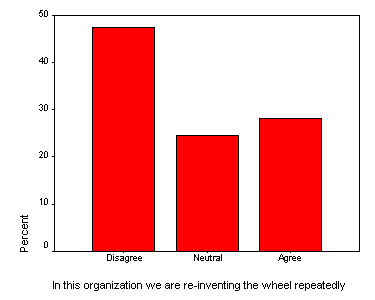
Figure 5
Lawyers share their knowledge already but do this (frequently) unconsciously. From our research it becomes clear that lawyers ensure particularly that their knowledge is shared within their section. Lawyers consider sharing knowledge with colleagues within a section obvious (see figure 6). Lawyers share their knowledge in a timely fashion with others within their section (see figure 7).
Figure 6
Figure 7
Generally lawyers also share their skills with others within their section (see figure 8). And when colleagues within their section ask for it, lawyers tell what they know (see figure 9).
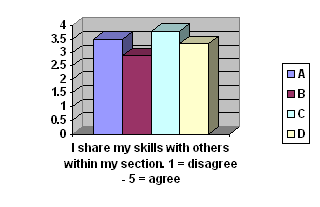
Figure 8
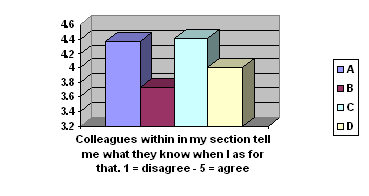
Figure 9
Knowledge is frequently not well shared between sections in law firms. Lawyers generally do not always share their knowledge with colleagues outside their section (see figure 10). Lawyers indicate having no time to share knowledge with others (see figure 11).
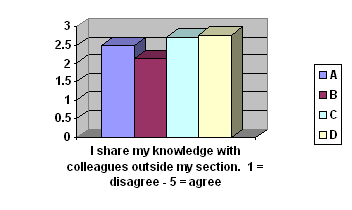
Figure 10
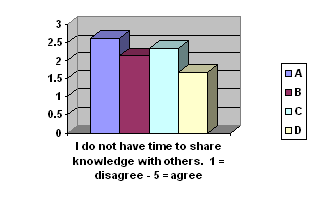
Figure 11
It seems there is a difference between actually sharing knowledge and the willingness to share knowledge. We just saw that knowledge is not well shared between sections, but lawyers also generally appear to be willing to share knowledge. Colleagues outside a section of a lawyer tell him what they know when asked for this (see figure 12).
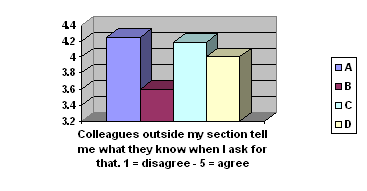
Figure 12
Employees not only share knowledge with each other by personal contact but also by using software applications. From research at law firms in 2005 it becomes clear that lawyers generally find that the software applications in their organization support the sharing of knowledge (see figure 13).

Figure 13
A manager of a large law firm noticed, however, that adding new knowledge developed by its lawyers to in-company software applications does not take place often. However, it is clear that more existing knowledge is retrieved from software applications than new knowledge is added to it according to the manager. Another manager said that it costs much time and effort of employees to add knowledge to software applications such as the intranet. Moreover, these activities cannot be billed. Lawyers are frequently not certain what happens with their explicit knowledge once it is stored in software applications: who has access to that explicit knowledge?
3.3.3 Evaluate Knowledge
Several developments have contributed to the fact that evaluating knowledge plays an important role in the work of lawyers [32]:
- in law practice more and more software applications are used and relied upon;
- the form of publication of legal sources in software applications deviates gradually more from the original form (the text is for example summarized or structured in rules); and
- an increasing number of sophisticated software applications are able to reason independently and take legal decisions.
From the research of Jongedijk and Matthijssen in 2002-2003 under 21 Dutch law firms it became, amongst others, clear that knowledge in law firms becomes obsolete rapidly [33]. Insufficient evaluation of knowledge can lead to lawyers delivering not what would be expected from them. From the research for this article it becomes clear that sources are not always regularly evaluated within law firms (see figure 14).
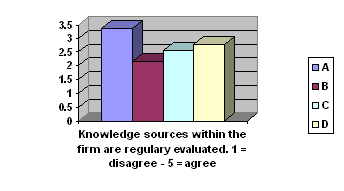
Figure 14
From research at law firm E in 2005, it became clear that employees do not frequently take the time to evaluate a rounded project with respect to what went well and what did not and could be improved (see figure 15), the so-called lessons learned.
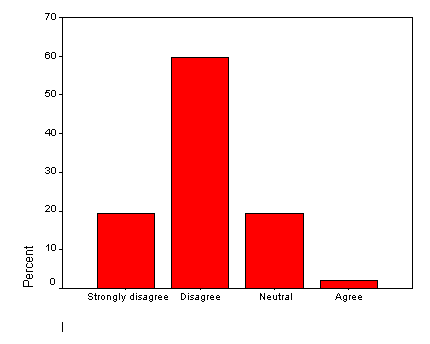
Figure 15
Lawyers indicate in addition that mistakes are not always used to learn (see figure 16).
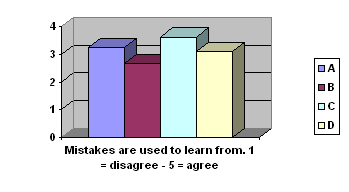
Figure 16
What we saw is that especially knowledge sharing between sections and supporting others to develop their knowledge lacks attention. Secondly, the evaluation of knowledge deserves more attention. Information Technology (IT) offers tools to support the knowledge processes, such as sharing and evaluating knowledge. In the next section we look at research of IT support for KM in law firms.
4. Information Technology in Law Firms
4.1 Introduction
Law firms have invested heavily in IT support [12,15,29,2]. For many law firms, KM is even synonymous with IT [23]. The pivotal role Information Technology plays in law practice is nicely illustrated by Quirchmayr [22] : “Information retrieval skills are more and more often outclassing human memory, especially in legal cultures that are based on precedents, previous High and Supreme Court decisions.”
Despite investements in IT, it seems that lawyers have been slow to adopt IT for managing information and knowledge [4,6] and the role of knowledge-based systems is of less significance [19].
4.2 A Taxonomy of IT Support for Lawyers
In combining several existing distinctions [3,14,13,28], we come to the following taxonomy of different types of IT support: word processors, databases, communication systems and knowledge-based systems.
Word processors are more and more equipped with standard documents. This type of support is from a practical perspective essential, but from a research perspective not that interesting. The use of databases with, e.g., case law and legislation, is indispensable for practical purposes, and poses some interesting research questions, though most are not primarily specific for the legal field. Internet, e-mail and groupware are some examples of communication systems. These systems are both very interesting from a practical and research perspective. Although echoes from the past can still be heard occasionally, it is generally agreed upon that lawyers cannot be replaced by knowledge-based systems. Knowledge-based systems or knowledge systems are not widespread in practice, but most interesting from a research perspective.
Our classification of IT in office automation, databases, communication systems and knowledge-based systems is rather general and clearly needs to be refined for practical use in law firms. With our taxonomy we want to illustrate that it is possible to give a clear overview of IT used by, or is of interest to, lawyers. Each IT-application has characteristics that can be used to evaluate how knowledge or knowledge process can be supported.
4.3 Use of IT for Knowledge Management in Law Firms
In the late nineties Gottschalk sent questionnaires on the use of IT to 256 large Norwegian law firms [6]. The respondents (28% response) were lawyers with special interest or responsibility for IT. IT did not seem to be widely used in law. The extent to which law firms in Norway used IT to support knowledge management was significantly influenced by the extent to which these firms used IT in general. Obviously, only law firms which already use IT for their core legal services will use IT to support knowledge management in their firms. Law firms which have a limited use of IT normally continue to stay away from technology.
In 2004, Jongedijk did research on KM and IT in 35 large Dutch law firms [8]. Sixty percent of these law firms had multiple departments and 71% had more than 5–10 sections or practice groups. Most law firms already made use of office automation and databases. New types of IT for knowledge management implemented or considered by many law firms are intranet. The most popular technology for sharing knowledge is e-mail. IT training is, amongst others, seen as an important critical success-factor for knowledge management.
Word processors, Databases and Communication Systems
The most popular application in law firms are word processors. Often word processors are equiped with standard models of letters and forms. Databases are the best known and most used software applications in law firms. From a study into the use of databases in 2004, it becomes clear that databases are frequently used in law firm C (see figure 17). From a study into the use of databases in 2005, it becomes clear that databases are frequently used in law firm E (see figure 18).
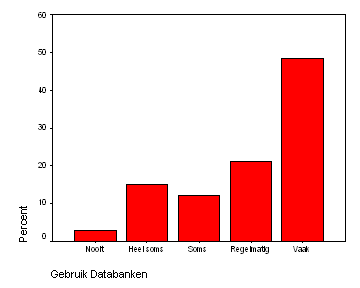
Figure 17
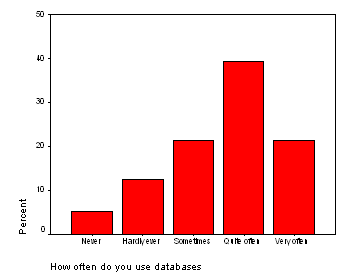
Figure 18
Internet
There are many applications on the Internet: discussion groups on bulletin boards, search engines (search for documents or software) and the World Wide Web (search with hyperlinks). The Internet is frequently used in law firms. From a study into the use of Internet in 2004, it becomes clear that the Internet is frequently used in law firm C (see figure 19). This also becomes clear from a study into the use of Internet in 2005, in law firm E (see figure 20).
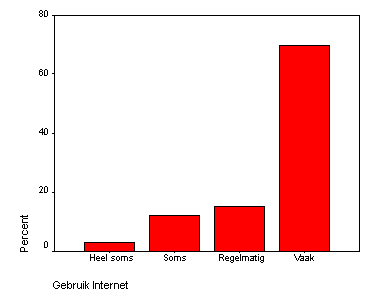
Figure 19
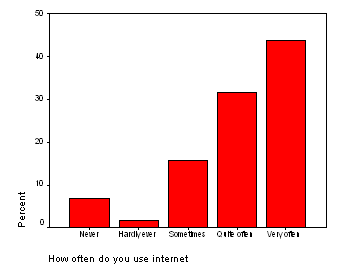
Figure 20
Intranet
The use of the intranet differs per firm. From a study into the use of intranet in 2004, it becomes clear that the intranet is used often in law firm C (see figure 21). From a study into the use of intranet in 2005, it becomes clear that the intranet is frequently used in law firm E (see figure 22).

Figure 21
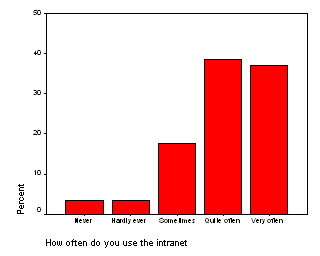
Figure 22
E-mail is a much-used software application in law firms. From a study into the use of e-mail in 2004, it becomes clear that e-mail is frequently used in law firm C (see figure 23). A year later this is also the case in law firm E (see figure 24).
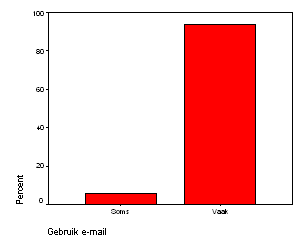
Figure 23
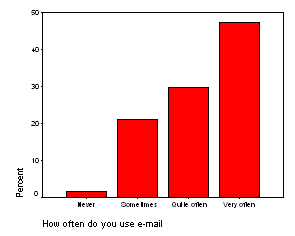
Figure 24
Groupware
Groupware offers support to the cooperation between people, irrespective of place and time. A well-known application of groupware in law firms is Lotus Notes with which a user can cooperate on-line, sent e-mail and get access to the intranet and Internet. Groupware is not often used by lawyers as became clear from the research in law firm C in 2004 (see figure 25). Groupware is frequently used by lawyers in law firm E as became clear from the research in 2005 (see figure 26).
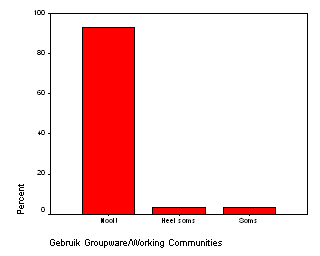
Figure 25
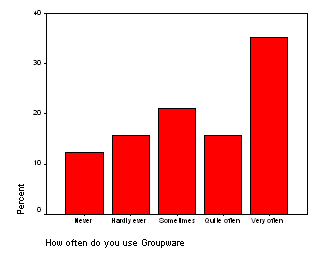
Figure 26
In another research amongst 247 law firms in Norway (response 37%), Gottschalk collected information on the type of IT applications that are used [7]. The firms’ responses indicate that word processing was the dominant technology, followed by electronic mail and external legal databases. The IT-intensive law firms seemed to have a relatively more extensive use of electronic mail and internal databases.
Knowledge-Based Systems
Knowledge-based systems are not the most popular systems in law practice. In 2003, Khandewal and Gottschalk examined the use of a number of knowledge-based systems such as expert systems, neural networks, intelligent agents and case based reasoning systems, in 47 Australian and 19 Norwegian law firms [36]. Their research shows that lawyers hardly use these systems:
|
Knowledge-based systems |
Norway |
Australia |
|
Expert systems |
1.6 |
1.7 |
|
Neural networks |
1.4 |
1.3 |
|
Intelligent agents |
1.2 |
1.4 |
|
Case based reasoning systems |
1.2 |
1.5 |
|
[36]. The results are the means of the scales 1 (little extent) – 6 (great extent). |
||
Knowledge-based systems that have been developed for Dutch law practice and are used, though limited are:
- Alimentatie Rekendisk: An electronic calculation application for law practice. With the Alimentatie Rekendisk it is possible to carry out complex alimony calculations. 1
- MRE Algemene Bijstand: MRE Algemene Bijstand supports the ‘General Assistance Act’ (Algemene Bijstandswet, Abw). MRE supports the consultant and the reviewer with applications, modifications and termination concerning periodically paid benefits. With MRE the consultant collects all relevant data and the relevant allowances, lowerings, conditions and sanctions are processed automatically. MRE provides the consultant with practical explanations and current case law. 2
- BOS (Beslissing Ondersteunend Systeem): Supports the Public Prosecution Department at formulating a sanction in a criminal case. The Public Prosecution Department fills in a number of factors such as offence-type, use of violence and the degree of repetition of offence whereupon BOS on that basis recommends what would be an appropriate sanction in a certain case. 3
Kay conducted a research on IT in 12 US and 6 UK law firms in 2002 [9]. Many firms in the US are awaiting for the killer application, that will, in one swift installation, meet all their knowledge sharing needs. This reminds of the expectations some people have regarding Artifical Intelligence.
So, lawyers only seem to deploy relatively simple technologies such as text-editors, e-mail and databases. Whether these tools support knowledge development, sharing and evaluation really effectively is questionable. Lawyers are, however, often not aware of the possibilities of Information Technology and it is often not clear to them how IT can be used to manage their knowledge [13,3,10]. In the next section we propose a framework to support lawyers in using IT to support their knowledge and knowledge processes.
5. A Framework for KM: Interdependencies Between Knowledge, Knowledge Processes and Information Technology
In the previous sections we introduced the elements knowledge, knowledge processes, and Information Technology, and presented rough taxonomies for each of these elements. We would need a three dimensional table to integrate the elements into one table. In this paper we solely focus on the role of Information Technology in relation to knowledge processes (we use our taxonomy of knowledge and knowledge processes in combination). So, for now a two dimensional table suffices. Based on our descriptions of each element, we have indicated how well the different Information Technology applications could support knowledge processes:
- + = support is available;
- +/- = needs some support; and
- - = offers insufficient support.
Our indications are tentative (and not as extreme as might look at first sight).
|
IT |
Word processor |
Databases |
Internet |
Intranet |
|
Groupware |
Knowledge systems |
|
|
Knowledge processes and knowledge |
||||||||
|
Develop administrative data |
+ |
+ |
+/- |
+ |
+/- |
+/- |
- |
|
|
Develop declarative knowledge |
+ |
+ |
+ |
+ |
+ |
+ |
+ |
|
|
Develop procedural knowledge |
+ |
+ |
+ |
+ |
+ |
+ |
+ |
|
|
Develop analytical knowledge |
+ |
+ |
+/- |
+ |
+/- |
+/- |
+ |
|
|
Share administrative data |
+ |
+ |
+/- |
+/- |
+/- |
+/- |
+/- |
|
|
Share declarative knowledge |
+ |
+ |
+ |
+ |
+ |
+ |
+ |
|
|
Share procedural knowledge |
+ |
+ |
+ |
+ |
+ |
+ |
+ |
|
|
Share analytical knowledge |
+ |
+ |
+/- |
+/- |
+/- |
+/- |
+ |
|
|
Evaluate administrative data |
+ |
+ |
+ |
+ |
+ |
+ |
+/- |
|
|
Evaluate declarative knowledge |
+ |
+ |
+ |
+ |
+ |
+ |
+ |
|
|
Evaluate procedural knowledge |
+ |
+ |
+ |
+ |
+ |
+ |
+ |
|
|
Evaluate analytical knowledge |
+ |
+ |
+ |
+ |
+ |
+ |
+ |
As indicated, the taxonomies are rather general and need to be refined for practical use. The same goes for integrating the taxonomies into this table. By proposing and integrating taxonomies of knowledge, knowledge processes and IT, we want to illustrate a way to classify and combine these core KM elements. The resulting framework can be used by lawyers as a starting point and should be refined to fit into a specific situation of a lawyer or law firm.
- Develop administrative data: With the help of a word processor a lawyer can relatively easy study, combine and edit administrative data. Databases can be used by him to retrieve and combine data. A lawyer can try to use the internet to find more data on clients, but much administrative data, e.g. data on clients, is confidential and is for security reasons not published on the internet. A better way for the lawyer to find administrative data is by using an intranet which can be secured more safely and is more oriented towards the needs of lawyers in a law firm than the internet. A lawyer can receive e-mail with new administrative data. E-mail is relatively easy to use but its security can not be guaranteed and so is mainly useful to send and receive non-confidential administrative data. The same goes for groupware; it is not always clear what happens to data when sent across a computer-network. Internet, intranet, e-mail and groupware offer good possibilities though for lawyers to get in touch with each other and consequently meet each other in person. Knowledge systems are usually not aimed at developing administrative data. But, although currently subject of research, intelligent agents may help a lawyer to find new administrative data by browsing the internet for example.
- Develop declarative knowledge: A word processor can be used to combine and clarify “knowledge of the law’’. Nowadays large quantities of declarative knowledge can be found in databases that can be used to develop declarative knowledge. Many of these databases can be found on the internet but also many websites contain declarative knowledge. But it is often hard to find the right source on the internet which is enormous nowadays and not every source can be relied upon. The intranet is a good medium to store specific declarative knowledge needed by lawyers within a law firm. A lawyer can easily use e-mail to ask for help in case he wants to know more about specific declarative knowledge. The same goes for groupware, which also has the advantage of allowing direct contact with a colleague. Knowledge systems can help a lawyer answering questions regarding declarative knowledge.
- Develop procedural knowledge: A lawyer can use a word processor to explain or to study procedural knowledge. A word processor can also be equipped with standard forms (e.g. contracts) and guides on how to apply these forms. Procedural knowledge can easily be stored in and retrieved from databases. It can also be found in databases on the internet. Procedural knowledge specifically used within a law firm can easily be retrieved from the firm’s own intranet. With the help of e-mail and groupware a lawyer can consult colleagues about specific procedural knowledge. Knowledge systems may advise lawyers in applying procedural knowledge.
- Develop analytical knowledge: With the help of a word processor a lawyer can study and combine analytical knowledge that has been made explicit. When analytical knowledge can be made explicit it may be stored in and retrieved from a database in a particular law firm. Analytical knowledge is a combination of declarative knowledge applied to a particular fact setting. Because it is so specific it may be hard to find on the internet. On the other hand, law firms can gather this knowledge amongst their own lawyers and publish it on their intranets. Analytical knowledge is usually complex and it may be difficult to formulate and sent questions with the help of e-mail and groupware. Usually personal contact makes it easier to get feedback. Knowledge systems try to reach conclusions about the course of action in a specific situation and so help a lawyer to develop analytical knowledge.
- Share administrative data: A word processor is a good way to clarify administrative data and so to improve sharing it. Administrative data can easily be stored and shared with the help of databases. Therefore it is necessary to make users aware of the database to use. Administrative data may be confidential and it may not be safe to share it with the help of hard to secure applications such as the internet, e-mail, groupware and knowledge systems such as intelligent agents. The intranet on the other hand is often meant as a secured internal internet. For non-confidential data all these applications are a good way for sharing.
- Share declarative knowledge: Word processors can be used to make declarative knowledge understandable when necessary and so easier to share. Declarative knowledge can easily be stored in and shared with databases. It is also relatively easy to share declarative knowledge with the help of internet, intranet, e-mail and groupware. In the future intelligent agents may be used to share declarative knowledge.
- Share procedural knowledge: Procedural knowledge can easily be edited with the help of word processors and consequently be made ready for sharing. Databases can be used to store and share procedural knowledge and it is also relatively easy to share this knowledge (taking into account the legal aspects) with the help of internet, intranet, e-mail and groupware and in the future maybe intelligent agents.
- Share analytical knowledge: Word processors can be used to clarify and structure analytical knowledge that has been made explicit. When made explicit it is possible to store this knowledge in databases. Applications such as the internet, intranet, e-mail and groupware can be used to share analytical knowledge. Because analytical knowledge is complex, personal contact may be preferred. Analytical knowledge may implemented within a knowledge system and so be shared with less experienced employees.
- Evaluate administrative data: A lawyer can use a word processor to compare and evaluate administrative data. He can retrieve this data from various databases. He can use the internet, intranet, e-mail and groupware to locate users to help him evaluate his administrative data. Knowledge systems are usually not developed to evaluate administrative data.
- Evaluate declarative knowledge: A word processor can be used to study and evaluate declarative knowledge from various sources. A lawyer can also use databases, the internet and intranet to retrieve and evaluate declarative knowledge. He can use e-mail and groupware to obtain feedback and get in touch with colleagues to evaluate declarative knowledge. Knowledge systems can be used to compare their application of declarative knowledge to solve a problem with that of the lawyer.
- Evaluate procedural knowledge: Procedural knowledge can be evaluated with the help of a word processor. With the help of a word processor a lawyer can compare documents that for example describe what forms should be filed in a specific situation. A lawyer can use databases to retrieve and compare documents in which procedural knowledge is applied in a specific situation. He may also find specific procedural knowledge on trustworthy sources on the internet and the intranet. With the help of e-mail and groupware a lawyer may contact colleagues that have applied procedural in same kind of situations and can support the lawyer to evaluate this knowledge. Knowledge systems may be used by a lawyer to compare both their application of procedural knowledge in a same kind of situation.
- Evaluate analytical knowledge: With the help of a word processor a lawyer can make analytical knowledge more understandable which consequently simplifies the evaluation of this knowledge. Analytical knowledge can partly be found in databases. A lawyer can use databases to compare both its and his analytical knowledge. The internet and intranet may be used to evaluate analytical knowledge by comparing various sources. E-mail and groupware can be used to find and contact colleagues that have applied the same kind of analytical knowledge and can help with evaluating that knowledge. A knowledge system may be used to find out how that system applied analytical knowledge in a specific situation.
In theory IT provides lawyers many possibilities to manage their knowledge. In this section we briefly discussed some of these possibilites. Although we could not provide a thorough and detailed analysis, we illustrated some possibilities IT has to offer to legal knowledge management. In the next section we will explain how our framework might be used to assist lawyers.
6. How a Framework Can Assist the Lawyer
With the help of our concept of a framework for KM, a lawyer may become aware of the existence of different types of knowledge. Raising awareness is an important first step towards optimal knowledge management. Our framework can be used as a starting point for classification. On basis of a legal task a lawyer can get an idea of which knowledge he uses or needs and can organize his knowledge. We for example see that lawyers often have trouble retrieving and storing the right knowledge. The structure of databases is often not based on the knowledge used and needed by individual lawyers. By organizing their knowledge, it becomes possible to adjust and refine the structure of IT to the way lawyers work instead of the other way around. Further, by comparing the knowledge needed by various lawyers, it becomes clearer what knowledge is really needed in the law firm as a whole.
With our framework, a lawyer might get an idea of the possible knowledge processes he can deploy. Based on his legal task the lawyer may find out what knowledge processes are already important to him. A lawyer could also decide to pay more attention to a knowledge process that is part of our framework. An idea behind our framework is to make it possible to compare knowledge processes of various lawyers and to focus on the support of knowledge processes that need more attention. Currently IT can support more than one knowledge process, but there is no overview in law firms of what knowledge processes are important to lawyers. There are a lot of investments in IT but it is not clear which IT supports what kind of knowledge process. And so it seems that IT is used quite randomly to support knowledge processes. By organizing knowledge processes of lawyers it becomes clearer which knowledge processes are important to lawyers. And so more specific investments in IT support can be made.
Our framework also provides a lawyer with a general overview of various means of IT support. Based on such an overview, the lawyer gets a first impression of the IT already used by him, or IT that might turn out profitable to him. Currently we see that there is usually a whole range of IT support available in law firms. This makes it hard for a lawyer to select the right type of IT. By making clear distinctions between forms of IT support, it becomes easier for lawyers to select the right type of support. However, therefore the framework needs to be further refined and elaborated upon.
In this paper we claim that taxonomies of the core elements of knowledge management will help individual lawyers in law firms to clarify their needs regarding the use of IT. This is important, because of the central role knowledge as well as IT plays in law firms. A lawyer needs to be supported adequately. The present paper delivers a rough sketch, but in our opinion already makes clear what we are heading at, and, more importantly, illustrates how taxonomies can be used in KM and also shows the importance of its use. In future research the taxonomies need to be further elaborated upon.
The framework for KM now under development could be used by the (knowledge) manager too, but we believe that awareness on the side of the individual lawyer regarding the use of IT is essential. The development of a framework for KM is in our opinion important for a number of reasons. First of all, it helps to get an overview of and helps to integrate “stand-alone” research on legal knowledge sources and Information Technology. Secondly, it presents research on knowledge management and so offers new perspectives on developing legal IT. Third, the focus on individual lawyers might raise the interest of lawyers in research and so help to improve taxonomies of legal knowledge sources and the development of legal IT. By exploring knowledge sources and IT in law practice, research might contribute to the optimalisation of legal knowledge management.
The framework lined out in this paper needs to be further elaborated upon. The various entries of the ultimate three dimensional table should be refined, and where appropriate divided into subcategories. Obviously, the relation between knowledge and knowledge processes also needs to be described. The use of IT in knowledge management should be improved, and our framework can be of help there. What is needed in the end is informed lawyers who are interested in the use of IT and that can express their needs adequately. The use of IT in legal practice will become ever more pervasive. We hope to contribute to IT support that is meaningful, in particular in the eyes of the individual lawyer.
[1] M. Apistola and A. Oskamp. Preparing knowledge management for law practice. In Proceedings of Jurix , 2001.
[2] A. Bos. Automatisering klinkt voor advocaten onaangenaam. Advocatenblad , 1996.
[3] R.V. de Mulder and A. Oskamp. Juridisch kennismanagement. In A. Oskamp and A.R. Lodder, editors, Informatietechnologie voor juristen - handboek voor de jurist in de 21ste eeuw . Kluwer, Deventer, 1999.
[4] D.L. Edwards and D.E. Mahling. Toward knowledge management systems in the legal domain. ACM , 1997.
[5] R. Florijn, M . van Gurchom, and M. van der Meulen. Kennis leren managen - de theorie en praktijk van kennismanagement . Ten Hagen & Stam, 2000.
[6] P. Gottschalk. Use of it for knowledge management in law firms. Journal of Information Law and Technology , 1999.
[7] P. Gottschalk. Use of it in law firms as enabler of inter-organisational knowledge networks. Journal of Information Law and Technology , 2000.
[8] S. Jongedijk. Stand van kennismanagement in de advocatuur. Technical report, Catalyse Business Consultants, 2004.
[9] S. Kay. Benchmarking knowledge management in us and uk law firms. LLRX.com , 2002.
[10] J. Lamont. Km and the law: The verdict is in. KM-World , 2001.
[11] P. Leith and A. Hoey. The computerised lawyer . Springer-Verlag, 1991.
[12] K. Martin and J. Hokkanen. How to implement technology. Law Technology News , 1999.
[13] L. Matthijssen, W. Voermans, and M.C.M. Weusten. Informatietechnologie voor juristen - handboek voor de jurist in de 21ste eeuw , chapter IT-toepassingen in de juridische praktijk. Kluwer, 2002.
[14] L. Matthijssen and M.C.M. Weusten. Typologie van juridische informatietechnologische toepassingen. In A. Oskamp and A.R. Lodder, editors, Informatietechnologie voor juristen . Kluwer, Deventer, 1999.
[15] B. Onwusah. The investment conundrum. Draft, 1997.
[16] A. Oskamp. Het ontwikkelen van juridische expertsystemen - een theoretische beschouwing. PhD thesis, Vrije Universiteit Amsterdam, 1990.
[17] A. Oskamp. Onderneming en ICT , chapter Beheer van Juridische Kennis in het IT-tijdperk. W.E.J. Tjeenk Willink, 2000.
[18] A. Oskamp. Agenten terecht! Kluwer, Deventer, 2002.
[19] A. Oskamp and M. Lauritsen. AI in law practice? So far, not much . Kluwer Academic Publishers, 2002.
[20] A. Oskamp, M.W. Tragter, and A.R. Lodder. Mutual benefits for ai&law and knowledge management. In Proceedings of the 7th International Conference on Artificial Intelligence and Law , New York, 1999.
[21] G. Probst, S. Raub, and K. Romhardt. Effectief omgaan met kennis . Scriptum Management, 2000.
[22] G. Quirchmayr. Internet, WWW, and beyond . Kluwer Academic Publishers, 2005. Forthcoming.
[23] G. Rusanow. Knowledge Management and the Smarter Lawyer. ALM Publishing, 2003.
[24] G. Schreiber, H. Akkermans, and A. Anjewierden. Knowledge Engineering and Management . MIT Press, 2001.
[25] R. Susskind. Expert systems in law . Claredon Press, 1987.
[26] B. van den Hoof, J. de Ridder, and J. Vijvers. Knowing what to manage. Third European Conference on Organisational Knowledge, Learning and Capabilities , 2002.
[27] T. van Engers. Goed geregeld? Het recht als ontwerpvraagstuk . Amsterdam University Press, Amsterdam, 2004.
[28] W. Voermans and R.W. van Kralingen. Informatie- en communicatietechnologie in de juridische praktijk. In A. Oskamp and A.R. Lodder, editors, Informatietechnologie voor juristen . Kluwer, Deventer, 1999.
[29] M. Voorhuis. Concurreren met behulp van it. Advocatenblad , 1997.
[30] M. Weggeman. Kennismanagement - inrichting en besturing van kennisintensieve organisaties. Scriptum Management, 1997.
[31] M.C.M. Weusten. Kennismanagement in juridische organisaties. In A. Oskamp and A.R. Lodder, editors, Informatietechnologie voor juristen . Kluwer, Deventer, 2002.
[32] C.N.J. de Vey Mestdagh, J.J. Dijkstra & A. Oskamp, ‘Kwaliteitsbewaking van juridische informatie- en kennistechnologie’, in: A. Oskamp & A.R. Lodder (eds.), Informatietechnologie voor juristen , Deventer: Kluwer 2002, p. 137-138.
[33] S. Jongedijk, L. Matthijssen, Stand van kennismanagement binnen de advocatuur , Amstelveen: KPMG 2003.
[34] P.J. Hinds & J. Pfeffer, ‘Why organizations don’t know what they know. Cognitive and motivational factors affecting the transfer of knowledge’, in: M. Ackerman, V. Pipek, V. Wulf (red.), Beyond Knowledge Management. Sharing Expertise , Cambridge: MIT Press 2003, p. 6.
[35] Boersma , Jacques, Management van kennis, een creatieve onderneming.
Koninklijke Van Gorcum, Assen, 2002,
[36] Khandelwal, V. and Gottschalk, P. (2004), "Stages of Knowledge Management Technology: A Comparison of Law Firms in Norway and Australia", Information Resources Management Conference 2004 , May 23-26, New Orleans, USA
1 See < http://www.ksu.nl/prodinfo/Alimentatie.shtml>.
2 See < http://www.kluwermre.nl/>.
3 See < http://www.om.nl/bos>.

